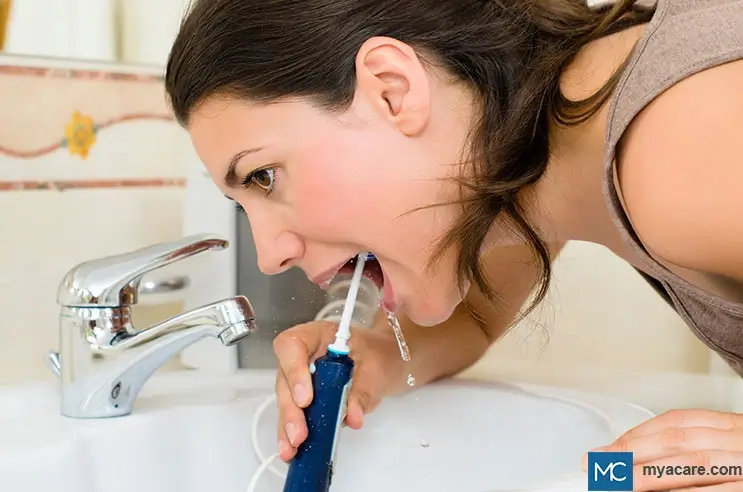Conventional Flossing vs. Water Flossing – Which Is Better?

Updated 2 May 2024
Flossing of teeth aids in the easy removal of food debris or bacterial film (plaque), protecting teeth from decay or gum infections. Conventional flossing of teeth, performed using a string of dental floss, is effective in removing about 80% of plaque from tooth surfaces. However, only 30% of the US adult population floss daily. This could be due to a lack of motivation or skill. To improve the flossing experience, several variations to conventional flossing have been introduced. One of them is a water flosser which mimics the dentists’ scaler unit (cleaning device) and uses a jet of water to clean areas between the teeth and gums.
In this article, we discuss the benefits and shortcomings of conventional and water flossing to help you make an informed choice.
Conventional Flossing Using Dental Floss
Conventional flossing is performed using a string of dental floss in between teeth. Dental flosses are made up of nylon threads and are available in waxed and unwaxed forms.
How to Use Dental Floss
While flossing, around 18 inches of floss is taken and both ends of the floss are encircled around the middle fingers of both hands. With the help of the index finger and thumb of each hand, floss is inserted in between teeth. It is then wrapped around the teeth, forming a C shape and moved in an upward and downward direction against the tooth surface to clean the food debris or bacterial film. It is recommended to floss the teeth at least once a day.
Benefits of using dental floss
- It is effective in removing food debris stuck between the teeth.
- It is inexpensive, affordable, and accessible. For instance, people in the US can buy floss for a dollar or less at any grocery or pharmacy store.
- It can be easily controlled by the user.
- It can be easily carried and used anywhere.
Shortcomings of using dental floss
- It is difficult to insert the floss through tight contacts or inaccessible areas (especially between the second and third molar) in the mouth.
- It can injure gums and cause bleeding if excess pressure is applied while inserting a floss between the teeth.
- There is a learning curve in using dental floss correctly.
Water Flosser
A water flosser is a hand-held device that uses a jet of high-pressure water to clean the debris or plaque between the teeth and gums. Water flossers may be available in cordless or countertop forms.
The countertop model comprises of a reservoir or a water unit, base, handle, tips, and a cord. The water unit has a capacity to hold 12-22 ounces of water (approximately 350-650ml). The water unit is placed on a base that comprises buttons for pressure settings. The device has a handle that is connected through a cord. A tip is attached to the handle.
In contrast, the cordless type is lightweight, portable, and powered by rechargeable batteries. They have a small water reservoir with a capacity of 5-7 ounces (approximately 140-207 ml) and fewer pressure settings.
What is the Mechanism of Action of a Water Flosser?
The action of a jet of water in a water flosser is based on pressure and pulsation (vibrations). When the jet of pulsating high-pressure water contacts the embrasure space (area below the contact point between teeth), it widens into concentric circles and penetrates deep into the gums. Gradually, it disrupts the bacterial activity, flushes away bacteria underneath gums, and removes the food debris lodged between the teeth. Research suggests that the water pressure of 50-90 psi (pounds of pressure per square inch) is effective in performing these functions without damaging gums or oral tissues.
How to Use a Water Flosser
Here are the steps to use a water flosser:
- Insert the tip into the handle.
- Fill the reservoir unit with water and place it back into the base.
- Plug in the device and adjust the pressure settings.
- Hold the handle at an angle of 90 degrees to the mouth. Place the tip close to the mouth and lean over the wash basin.
- Turn on the unit and allow the water to flow out of the tip.
- Adjust the tip of the flosser so that it points towards the gum line.
- Start from the back teeth and slowly move the tip with a jet of pulsating water towards the front teeth.
- Take breaks in between to allow the water to flow out from the mouth into the sink.
- Turn off the unit and remove the tip once all the teeth are cleaned.

Benefits of water flosser
- It is easy to use.
- It can be used in teeth with tight contacts or diseased gums.
- It is safe and effective in cleaning food debris or plaque around implants, fixed teeth, and braces.
- The pressure setting can be changed as per the requirement or preference, diminishing the damage to the gums. For instance, lower pressure settings can be used on sensitive gums.
- Older people or people with muscle weakness may find it easier to use water flosser as it requires lesser skill compared to conventional floss.
Shortcomings of water flosser
- A water flosser requires an upfront investment (around $50-150 in the US) and regular replacement of tips (about $12-15). In contrast, a conventional floss costing between 1-7 USD in the US lasts 3-4 months.
- Tips of the water flosser are required to be changed every 3-6 months.
- Some people find it messy to use.
Features to Consider When Shopping for a Water Flosser
As mentioned above, water flossers are available in two forms - Countertop and Cordless models. Several crucial features can be considered while shopping for a water flosser. These include:
- Tank Size: In countertop models, the water unit can hold up to 35 ounces of water. Whereas, cordless flossers have smaller tanks and can hold 7 ounces of water. A larger tank size may allow longer flossing time without the need for refill. However, larger tank sizes may occupy more space. On the contrary, a cordless model is lightweight, requires less space, and is handy and easy to carry during travels.
- Pressure Settings: The pressure settings in water flossers determine the amount of force with which a stream of water is sprayed. A countertop water flosser offers 6 or 10 pressure settings between 10 and 120 PSI, whereas a cordless flosser offers 2 or 3 settings from 45 to 75 PSI. A low-pressure setting can be helpful for beginners and individuals with sensitive gums, while a relatively high-pressure setting can easily remove tough debris.
- Power source: While buying a water flosser, look for the source of power supply. Usually, the corded countertop model can be recharged by plugging the cord into an electric socket. Whereas, cordless models are powered by rechargeable or replaceable batteries.
- Nozzle options: You can choose a water flosser that offers multiple tips. These specialized tips are designed to remove the plaque and debris around braces, implants, fixed bridges, and periodontal pockets. In general, countertop models provide multiple tip options compared to cordless models.
- Warranty: While purchasing a water flosser, it is crucial to assess the specific terms of the warranty provided with the product. Warranties can differ between products and typically exclude consumable items, particularly tips.
- Water Pulsating Modes: Some flossers offer a pulsating water stream, which can be more effective at dislodging debris.
- Ease of Use: Consider factors like water reservoir filling, tip attachment/removal, and overall handling.
- Noise Level: Some users might be sensitive to noise, especially in countertop models.
- Auto-Shutoff: This feature can be helpful to prevent overuse and conserve water.
Overall, both models are effective in oral hygiene maintenance. However, if you seek a flosser for household use with a wide range of features, then the countertop model is preferable. Conversely, for travel or situations with space restrictions, the cordless model is the go-to option.
Conventional Flossing vs Water Flosser – Which is Better?
Research suggests that a water flosser is as efficient as conventional floss in removing the food debris or plaque present between teeth. People using water flosser experience less gum bleeding compared to conventional floss users.
However, the use of a water flosser can be messy because of the constant drooling of water. In contrast, conventional floss is easy to carry in a purse or a bag.
A water flosser is recommended for people who lack manual dexterity or have implants, braces, or multiple crowns in their mouth. Even people with mild or moderate gum infections may benefit from water flosser. This doesn’t mean that everyone has to replace conventional floss with a water flosser. People should continue using conventional floss if they find it convenient.
To search for the best dentists in Germany, India, Malaysia, Poland, Singapore, Spain, Thailand, Turkey, the UAE, the UK and the USA, please use the Mya Care search engine.
To search for the best healthcare providers worldwide, please use the Mya Care search engine.

Dr. Shilpy Bhandari is an experienced dental surgeon, with specialization in periodontics and implantology. She received her graduate and postgraduate education from Rajiv Gandhi University of Health Sciences in India. Besides her private practice, she enjoys writing on medical topics. She is also interested in evidence-based academic writing and has published several articles in international journals.
References:
Featured Blogs



